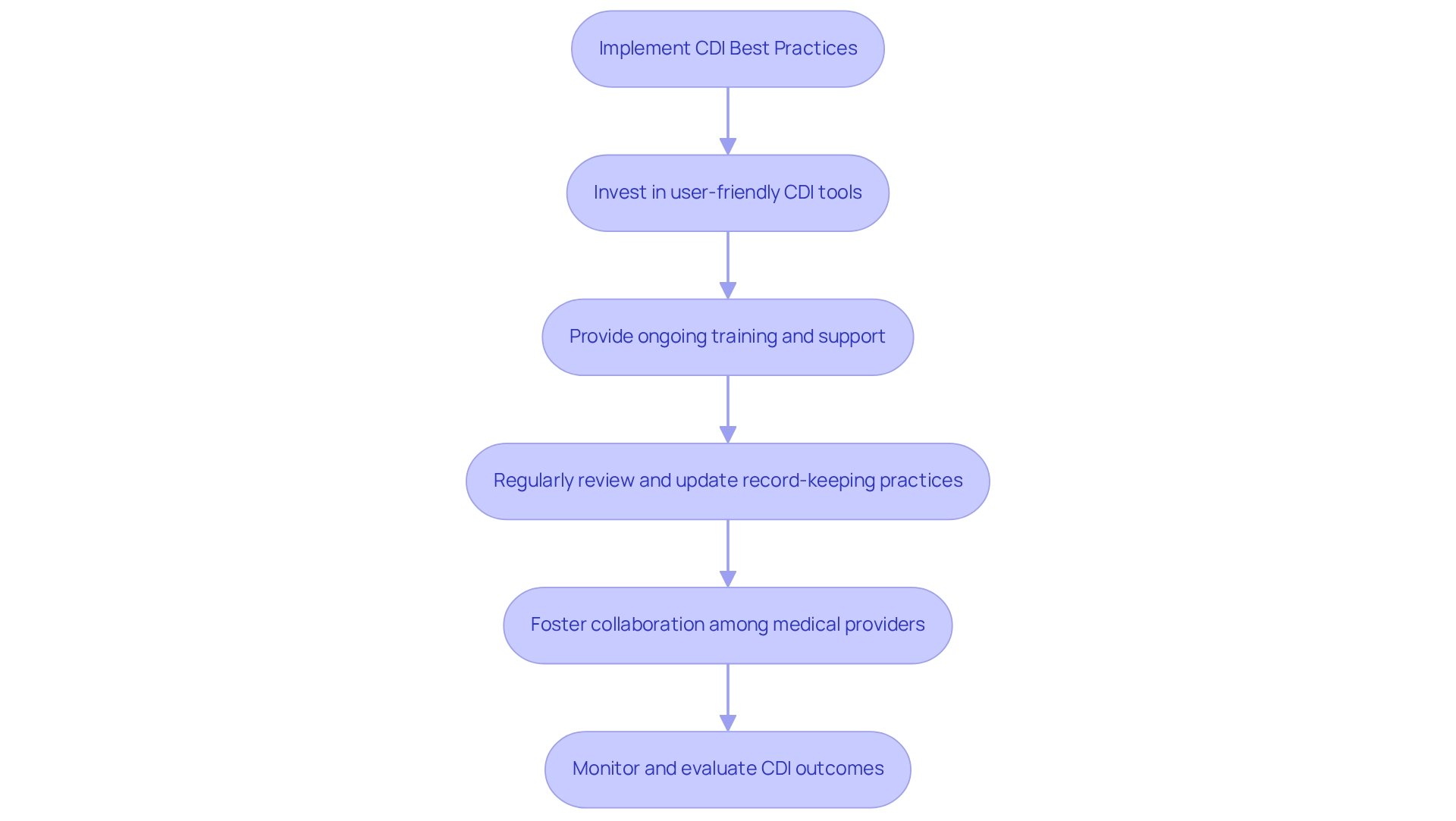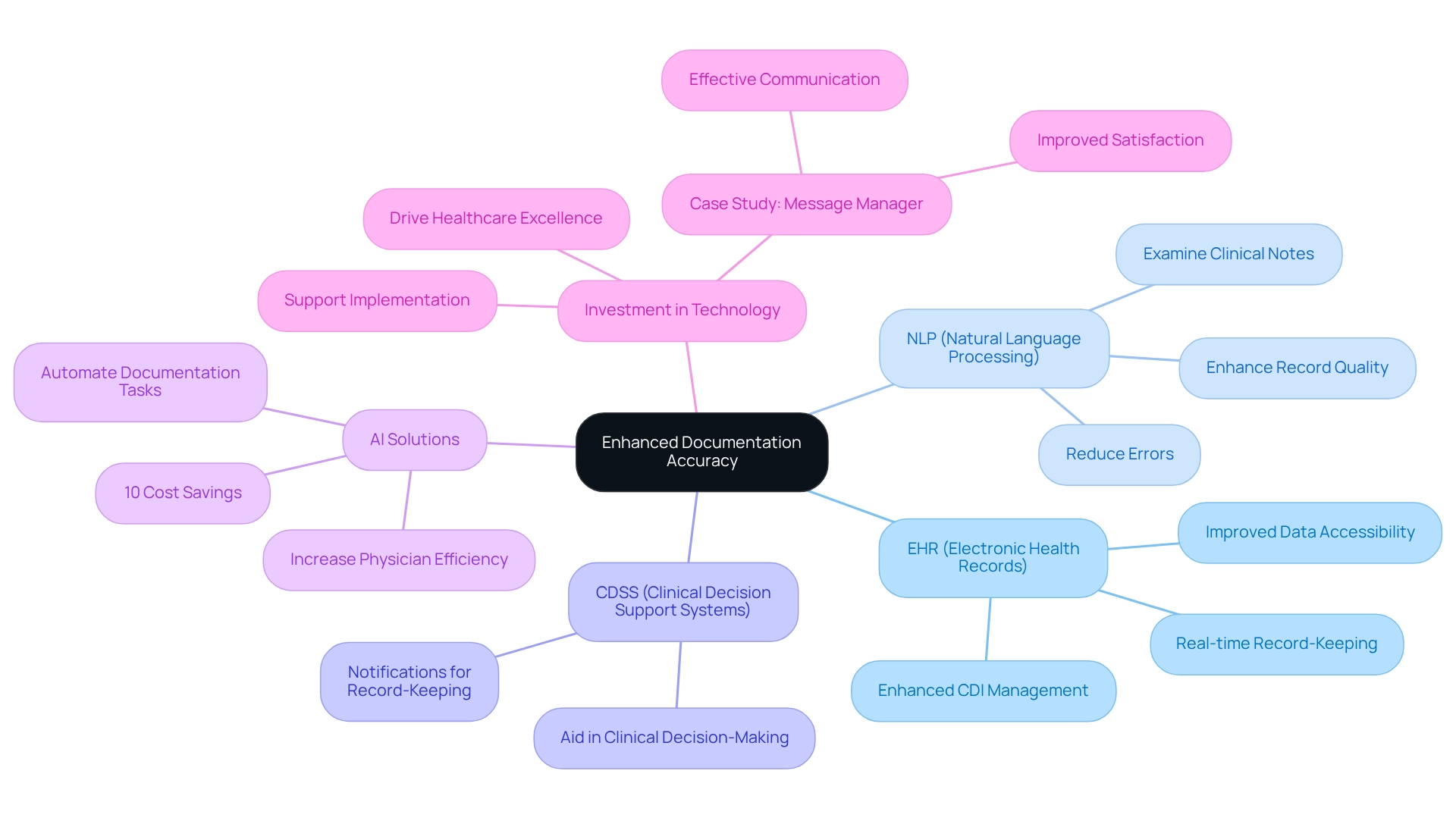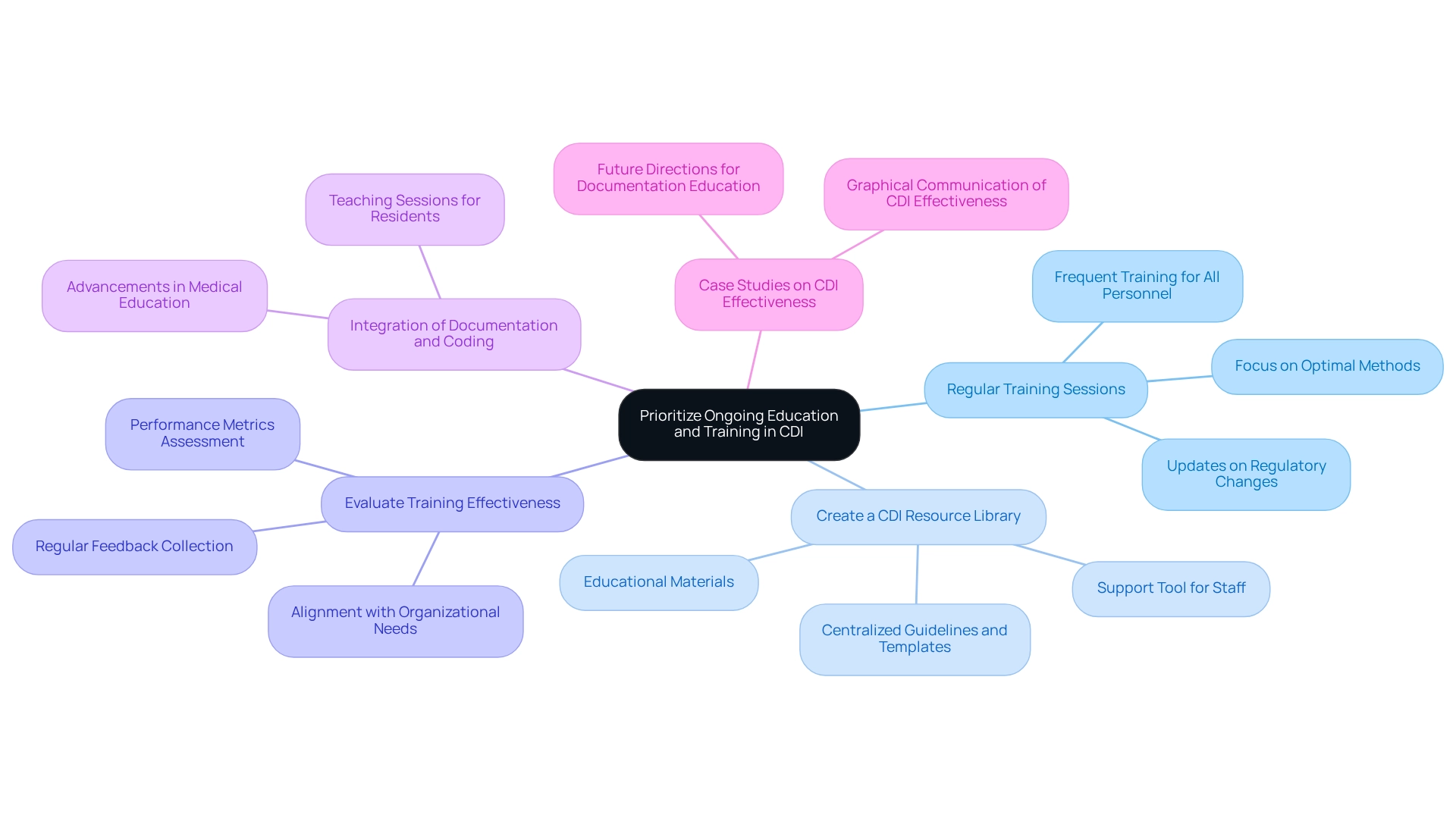Overview
In healthcare, providers often face significant emotional challenges, particularly when it comes to managing Clinical Documentation Improvement (CDI). The burden of administrative tasks can detract from the core mission of patient care. This article outlines five compassionate strategies aimed at optimizing CDI medical records, which can alleviate some of these pressures.
First, standardized practices play a crucial role in ensuring consistency and accuracy in documentation. Engaging physicians in this process fosters a collaborative environment where everyone feels valued and heard. Have you considered how physician involvement can enhance the quality of records?
Next, the power of data analytics cannot be overstated. By setting clear goals and utilizing user-friendly tools, healthcare providers can streamline their documentation processes. Regular training sessions empower staff and promote confidence in using advanced technologies like AI and NLP. These innovations not only enhance record accuracy but also contribute to improved patient care and operational efficiency.
Imagine a workplace where technology supports your efforts rather than hinders them. By leveraging these strategies, healthcare providers can experience a significant reduction in administrative burdens, allowing them to focus more on what truly matters: patient care.
Let’s take action together. Embrace these strategies and witness the positive impact they can have on your practice and the patients you serve. Your commitment to optimizing CDI is a step toward a more compassionate healthcare environment.
Introduction
In the ever-evolving landscape of healthcare, the significance of Clinical Documentation Improvement (CDI) stands as a vital foundation for enhancing both patient care and operational efficiency. Healthcare providers often face emotional challenges in accurately capturing patient information, and this is where the role of CDI becomes increasingly crucial. It ensures that diagnoses, treatments, and outcomes are documented with the precision that every patient deserves.
As we look to the future, projections indicate substantial growth in the CDI market, particularly in North America. This growth is accompanied by the integration of advanced technologies, such as AI and Natural Language Processing, which are revolutionizing the approach to clinical documentation. How can healthcare organizations harness these tools to alleviate the administrative burdens that often detract from patient care?
This article explores the strategies and tools that healthcare organizations can adopt to optimize their documentation practices. By focusing on effective CDI, we can transform not only patient outcomes but also financial performance. Together, let’s delve into how embracing these advancements can lead to a more compassionate and efficient healthcare environment.
Understand Clinical Documentation Improvement (CDI)
Clinical Documentation Improvement (CDI) involves systematic processes aimed at enhancing the quality and completeness of CDI medical records. This approach is essential for medical providers striving to accurately document patient diagnoses, treatments, and outcomes in CDI medical records, which directly impacts efficient patient care and reimbursement precision. By refining documentation practices, medical organizations can significantly reduce errors, improve communication among providers, and ensure compliance with regulatory standards.
The global clinical documentation improvement market is projected to reach USD 5.26 billion by 2025, with North America holding a substantial 47.8% market share as of 2023. This growth is driven by the increasing recognition of CDI's role in improving medical service delivery. Governments and private entities are investing in digital health technologies to enhance service delivery and reduce inefficiencies, further underscoring the importance of CDI in the healthcare landscape. Recent trends suggest a shift towards user-friendly CDI tools, particularly AI and NLP-enabled software, which are expected to boost adoption rates across various medical environments.
Leaders in the medical field emphasize the transformative impact of CDI on patient care and reimbursement. Effective CDI medical records practices not only enhance the accuracy of records but also improve the quality of care provided to patients. As medical professionals embrace these principles, they can refine their processes for CDI medical records, ultimately leading to better patient outcomes and financial success for their institutions. Moreover, in hospitals illustrate the tangible benefits of these initiatives. However, challenges such as high implementation costs and integration complexities remain, particularly for smaller medical providers. These obstacles can impede the adoption of advanced CDI solutions, which are crucial for improving patient care quality and maximizing reimbursement rates. Addressing these challenges is vital for promoting widespread adoption of CDI practices.
To effectively implement CDI best practices, medical providers should consider the following actionable steps:
- Invest in user-friendly CDI tools that utilize AI and NLP technologies.
- Provide ongoing training and support for staff to ensure proper use of CDI systems.
- Regularly review and update record-keeping practices to align with regulatory standards and best practices.
- Foster a culture of collaboration among medical providers to enhance communication and record accuracy.
- Monitor and evaluate CDI outcomes to identify areas for continuous improvement.

Implement Effective Strategies for CDI Optimization
To enhance (CDI), healthcare organizations can consider several compassionate strategies:
- Standardize Documentation Practices: Implementing standardized templates and guidelines can foster consistency and completeness across patient records. Research indicates that organized records significantly enhance note quality, evidenced by a notable rise in quality across eight of the eleven elements assessed by the Qnote instrument. Additionally, incorporating organized cdi medical records into Electronic Health Records (EHRs) enhances data reuse and efficiency, optimizing workflows and improving overall record-keeping methods.
- Engage Physicians in CDI Initiatives: Collaboration between CDI specialists and physicians is vital for nurturing understanding and adherence to recording standards. Regular training sessions and feedback systems can encourage this involvement, leading to enhanced record-keeping methods. Engaging physicians in these initiatives has been shown to improve outcomes in efforts related to CDI medical records. As Robert P Takes, MD PhD, states, "structured record-keeping can enhance provider efficiency and reduce recording time," underscoring the importance of physician involvement.
- Utilize Data Analytics: Employing data analytics can help identify trends and areas needing improvement in record-keeping methods. This approach allows organizations to pinpoint frequent mistakes and tailor training initiatives effectively, ensuring that record-keeping practices evolve in response to recognized challenges.
- Establish Clear Goals: Setting measurable objectives for CDI initiatives—such as reducing record errors or improving coding accuracy—creates a framework for tracking progress and accountability. The standardization of cdi medical records procedures has been linked to a reduction in variability and mistakes, as highlighted in the case study on standardization. This reinforces the need for clear objectives in achieving successful CDI outcomes. Furthermore, acknowledging the necessity for further research on organized record-keeping systems, as discussed in the case study 'Future Research Directions on Structured Documentation,' emphasizes the importance of adapting practices based on emerging evidence.
By applying these strategies, medical organizations can enhance their clinical record processes, ultimately leading to improved patient care and operational efficiency. Together, we can navigate these challenges and foster a more supportive environment for both healthcare providers and patients.
Leverage Technology for Enhanced Documentation Accuracy
Improving the accuracy of cdi medical records in the medical field is essential for enhancing patient care and operational efficiency. face emotional challenges as they navigate administrative burdens that can detract from their ability to deliver the best care possible. By addressing these concerns, we can foster a more supportive environment for both providers and patients.
Here are several effective strategies that can help:
- Implement Electronic Health Records (EHR): EHR systems facilitate real-time record-keeping and improve data accessibility, enabling medical providers to capture patient information with greater precision and efficiency. Present adoption rates of EHRs in healthcare suggest a notable transition towards digital solutions, with numerous institutions reporting enhanced cdi medical records management practices.
- Utilize Natural Language Processing (NLP): NLP tools examine clinical notes and propose improvements, ensuring that records are both comprehensive and precise. The effect of NLP on record accuracy has been profound, with studies indicating that it can reduce errors and enhance the quality of clinical records.
- Implement Clinical Decision Support Systems (CDSS): CDSS offer notifications and reminders for crucial record-keeping components, aiding clinicians in sustaining comprehensive and precise records. This proactive method not only improves record quality but also aids in better clinical decision-making.
- Integrate AI-Powered Solutions: AI technologies automate routine documentation tasks, allowing medical providers to concentrate more on patient care while ensuring that documentation remains accurate and current. The application of AI in medical services has led to increased physician efficiency and streamlined workflows, resulting in a notable 10% cost savings in administrative overhead, as highlighted in recent studies. Furthermore, AI can connect gaps in communication and coordination among providers, addressing the fragmentation frequently observed in medical delivery.
- Invest in Cutting-Edge Solutions: By investing in these advanced technologies, medical providers can drive excellence and future growth, ultimately enhancing the quality of care delivered to patients. As Dean noted, "Our organization has also had a great experience with the Residential Support team, who have been there to help us whenever our team has questions," emphasizing the importance of support in implementing these solutions.
Additionally, the case study of Donwood Community Aged Care Services illustrates how the Message Manager software facilitated more effective communication with residents’ loved ones, improving overall satisfaction and engagement. This strengthens the case for adopting advanced cdi medical records systems.
By leveraging these strategies, medical providers can significantly enhance documentation accuracy, leading to improved patient outcomes and operational efficiency. Tackling issues like fragmentation of medical systems and physician burnout through these innovative solutions is essential for creating a more effective delivery system. Together, we can foster an environment where healthcare providers feel supported and empowered to deliver the best care possible.

Prioritize Ongoing Education and Training in CDI
To ensure the success of (CDI) initiatives, healthcare organizations must prioritize ongoing education and training in CDI medical records. This commitment is essential, as many healthcare providers face overwhelming administrative burdens that can impact patient care. By recognizing these challenges, we can work together to enhance the quality of documentation and ultimately improve patient outcomes.
- Regular Training Sessions: Implement frequent training sessions for all personnel involved in record-keeping processes, including physicians, nurses, and administrative staff. These sessions should concentrate on optimal methods and updates on regulatory changes to keep everyone informed and compliant with CDI medical records.
- Create a CDI Resource Library: Establish a centralized resource library that houses guidelines, templates, and educational materials related to CDI medical records. This library will function as a valuable support tool for staff, improving their CDI medical records management efforts and ensuring consistency across the organization. This collaborative approach not only enhances knowledge sharing but also fosters a supportive environment for continuous improvement.
- Evaluate Training Effectiveness: Regularly assess the effectiveness of training programs through feedback and performance metrics. This assessment procedure guarantees that training aligns with the organization's requirements and enhances the quality of records.
Continuous education is essential for improving record-keeping practices, as shown by recent advancements in medical education that stress the integration of record-keeping and coding. As Bradley J Molyneaux, MD, PhD, observes, 'This subject is gaining significance, with growing focus on record-keeping and quality measures.' By investing in effective training programs, healthcare organizations can significantly improve documentation quality, ultimately leading to better patient care outcomes. Furthermore, case studies such as the one on graphical communication of CDI effectiveness demonstrate how organizations can effectively communicate the success of CDI programs, facilitating better decision-making and continuous improvement.

Conclusion
The importance of Clinical Documentation Improvement (CDI) cannot be overstated in the context of modern healthcare. By systematically enhancing the quality and completeness of clinical documentation, healthcare organizations can ensure the accurate capturing of patient information. This accuracy is crucial not only for patient care but also for the financial performance of these organizations.
As we look at the integration of advanced technologies like AI and Natural Language Processing, we see a transformation in the CDI landscape. These innovations make it easier for healthcare providers to maintain accurate records while alleviating administrative burdens. Have you considered how these tools can lighten your load and improve your practice?
Implementing effective strategies for CDI optimization is vital. Standardizing documentation practices and engaging physicians can lead to significant improvements in documentation quality and patient outcomes. Utilizing data analytics helps identify areas for improvement and fosters a culture of continuous learning and adaptation within healthcare organizations.
Furthermore, investing in user-friendly technologies, including Electronic Health Records and Clinical Decision Support Systems, enhances documentation accuracy and supports better clinical decision-making. Imagine the difference it could make in your daily workflow and the care you provide.
Ongoing education and training are essential for the successful implementation of CDI initiatives. By prioritizing regular training sessions and creating a centralized resource library, healthcare providers can ensure that all staff members are equipped with the knowledge and tools necessary to excel in their documentation practices. This commitment to education fosters collaboration and knowledge sharing, ultimately leading to improved patient care and operational efficiency.
As the healthcare landscape continues to evolve, embracing CDI and its associated strategies will not only enhance patient care but also contribute to the financial viability of healthcare organizations. The future of healthcare depends on accurate documentation, and the proactive steps taken today will pave the way for a more efficient and compassionate healthcare system tomorrow. Let’s take these steps together for a brighter future in healthcare.




